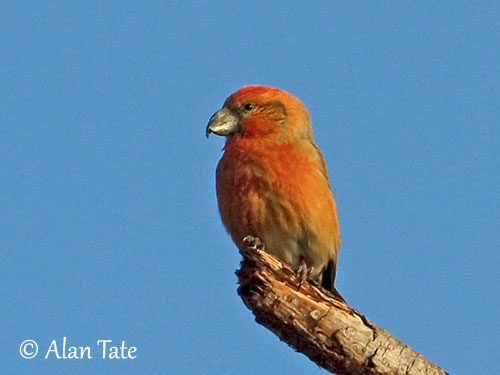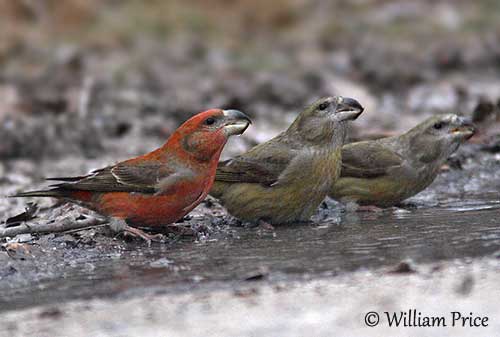
Fr: Bec-croisé perroquet
Ang: Parrot Crossbill
All: Kiefernkreuzschnabel
Esp: Piquituerto Lorito
Ita: Crociere delle pinete
Nd: Grote Kruisbek
Sd: större korsnäbb
Photographers:
William Price
PBase-tereksandpiper & Flickr William Price
Didier Buysse
Vision d’Oiseaux
Alan & Ann Tate
AA Bird Photography
Text by Nicole Bouglouan
Sources:
HANDBOOK OF THE BIRDS OF THE WORLD Vol 15 by Josep del Hoyo-Andrew Elliot-David Christie - Lynx Edicions – ISBN: 9788496553682
THE COMPLETE BOOK OF BRITISH BIRDS – Written by “Royal Society for the Protection of Birds” experts - Préface de Magnus Magnusson - Michael Cady- Rob Hume Editors - ISBN: 0749509112
THE HANDBOOK OF BIRD IDENTIFICATION FOR EUROPE AND THE WESTERN PALEARCTIC by Mark Beaman, Steve Madge - C.Helm - ISBN: 0713639601
ENCYCLOPEDIE DES OISEAUX DE FRANCE ET D’EUROPE – de Peter Hayman et Rob Hume - Flammarion – ISBN : 2082009920
FINCHES AND SPARROWS by Peter Clement, Alan Harris and John Davis – Helm Identification Guides – ISBN: 0713652039
Identification of Scottish and Parrot Crossbills
Vulkaner – Crossbills – Genus Loxia
Wikipedia, the free encyclopaedia
DESCRIPTION OF THE BIRD:
Biometrics:
Length: 17-18 cm
Wingspan: 30-34 cm
Weight: 44-69 g
The Parrot Crossbill adult male has head, nape, neck sides and upperparts deep brick-red, often variably washed or flecked darker, but the upperparts may show darker crimson mottling. The scapulars are similar or browner with brick-red tinge. The mantle is reddish-brown. The rump is reddish-pink and the uppertail-coverts are brown with dark reddish-brown edges. The tail is blackish with fine reddish-brown edges.
On the dark olive-brown upperwing, the median coverts are edged rufous-brown whereas greater coverts and secondaries are edged pinkish or fringed olive-brown. The primary coverts are edged reddish-brown.
Throat and underparts are dark red with some olive tinge on breast side, and orange or greyish on flanks. The undertail-coverts are whitish with fine dark streaks.
On the brick-red head, the lores are dusky and the eyestripe extending to rear of ear-coverts is grey to grey-brown.
The bill is deep and strongly arched towards the tip, with relatively straight culmen base. It is grey to greyish-horn, with paler cutting edges. The eyes are dark brown to black. Legs and feet are pinkish-brown.
The bird appears duller in worn plumage, with greyish to brownish wash above, whereas the underparts become brighter red with grey to grey brown feather bases. The eyestripe is broader and greyish.

Male left, with
two females
The adult female has greenish olive-grey head and upperparts. Mantle and back show dusky feather bases. The scapulars are darker olive-green. The rump is yellowish-green, the uppertail-coverts are similar but with dark centres to feathers. Tail and wings are like on male, but with fine dull olive edges.
The underparts are dull olive-yellow to yellowish, with sometimes green or grey tinge on breast sides and flanks. Belly to undertail-coverts is whitish with grey streaks. The bare parts are like on male but she has slightly smaller bill.
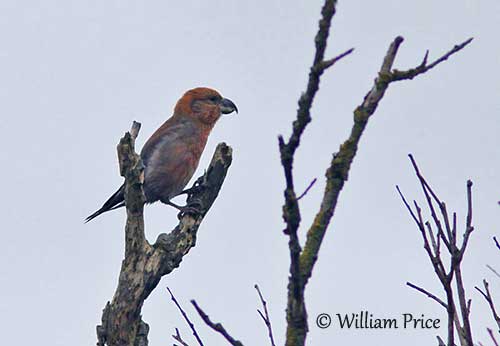
HABITAT:
The Parrot Crossbill is resident in pine forest, but when the food is less available in winter, it can be found in mixed conifer and deciduous woodlands.
It is usually found in tall, mature and open woodlands of Scot Pines (Pinus sylvestris) and sometimes in mixed forests with conifer, larch and spruce. It may frequent conifer plantations, even introduced conifer species producing large cones.
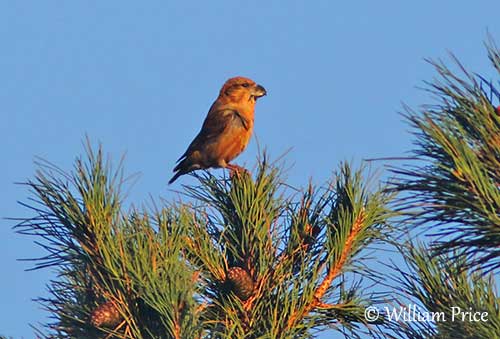
BEHAVIOUR IN THE WILD:
The Parrot Crossbill feeds on seeds, buds and shoots, especially of Scot Pine, but also spruce, larch, poplar, alder, and berries of Empetrum, Vaccinium, seeds of Circium, cereals and some insects.
The birds of genus Loxia (crossbills) are very specialized. Their bills are well-adapted to extract the seeds from the conifer cones. The bill of the Parrot Crossbill is stout and deep, allowing this species to concentrate on the large, hard pine cones.
This agile bird clambers among tree branches and on cones. Once the cone is broken off, the bird holds it with one foot while extracting the seeds with the bill.
It frequently drinks water at pools.
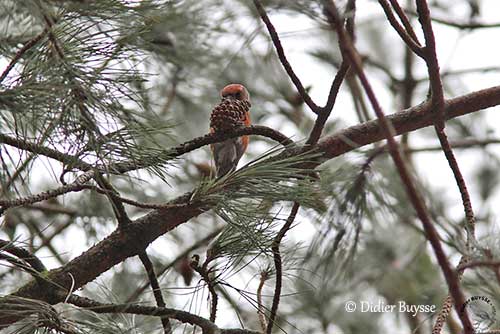
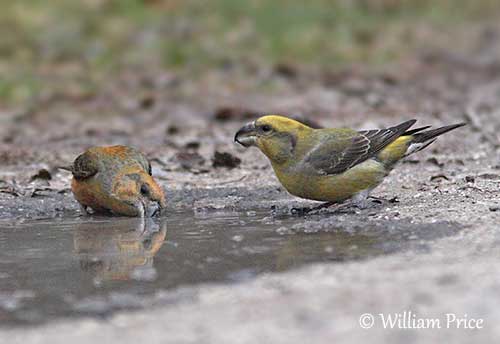
REPRODUCTION OF THIS SPECIES:
The breeding season usually occurs when the pine seeds are available. The breeding season takes place between December and late June, with the laying from mid-March to mid-April. This species produces two broods per season. It nests solitary, and occasionally in loose colonies.
The female builds the nest, a cup-shaped structure placed about 20 metres above the ground on branch, fork or close to the trunk in conifer at forest edge.
The nest is made of dry conifer twigs, pieces of bark, pine needles, grass, leaves, moss and lichens. It is lined with down, animal hair or fur, and sometimes feathers.
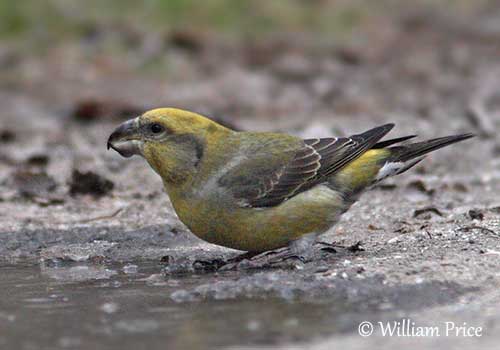
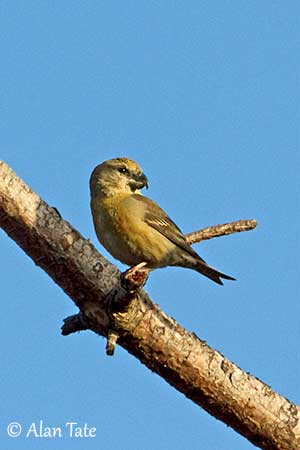
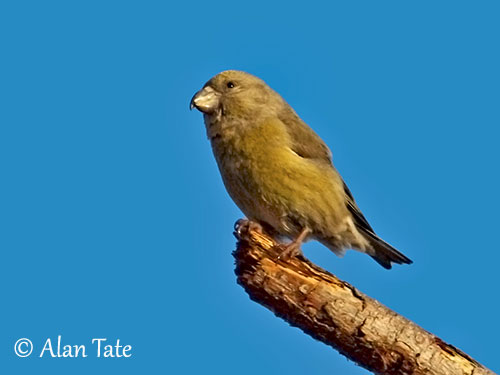
Like most Fringillidae, the Parrot Crossbill is probably monogamous during the season. The pair formation, takes place towards the end of the winter season.
The male displays and performs a butterfly-like song flight between trees. It also pursues the female through the trees, prior to copulation. Courtship feeding by male to female is common during the nest-building and continues through the incubation.
The Parrot Crossbill nests in a cup-shaped structure placed up to 20 metres above the ground in conifer. The female builds the nest but both parents feed the chicks.
The Parrot Crossbill is usually resident, but movements and irruptions are closely related to food availability. Family groups make post-breeding dispersal in July-August, performing local to short-distance movements within the breeding range, or S/SW of the breeding areas from mid-September to October/November. The return starts mid-February, but with peak in March, and great numbers are back in their breeding areas early April.
Irruptions are caused by failure of pine cone crop.
The flight is performed with rapid wingbeats interspersed with short glides.
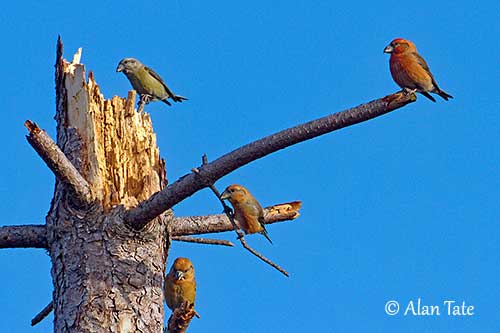
CALLS AND SONGS: SOUNDS BY XENO-CANTO
The typical calls of the Parrot Crossbill are very similar to those of the Red/Common Crossbill, but they are usually produced on deeper tone and the birds utter “choop-choop” rather than “chip-chip”.
It also gives a soft contact note “gop” when several birds are foraging together in trees. When excited or alarmed, it gives a deeper and harder “cherk”. The flight call is a deeper “chup-chup-chup”.
The Parrot Crossbill sings from exposed perch at treetop or in flight. The song is a long series including several call notes running together “chit,chit,chit-chit-chit tcho-ee tcho-ee”. We can also hear a series of “p-te-che p-te-che” and a piercing, slightly faster “chweeLER-chweeLER”. A long series of “chip” notes may sometimes follow these series.
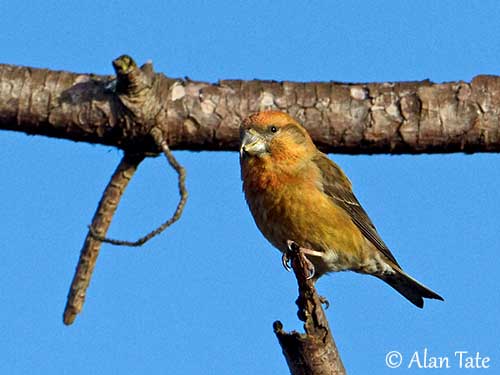
The juvenile male has head and upperparts dark olive/grey-green with dark streaks. Upperwing and tail are as on adult male with paler edges to feathers. The underparts are pale buffish-grey with dark streaks, except on belly.
The full adult plumage is acquired in late second winter or second summer.
RANGE:
The Parrot Crossbill breeds in NE Scotland, Fennoscandia, Estonia and N Latvia, S to E Lithuania and extreme E Poland, and E to SW Siberia.
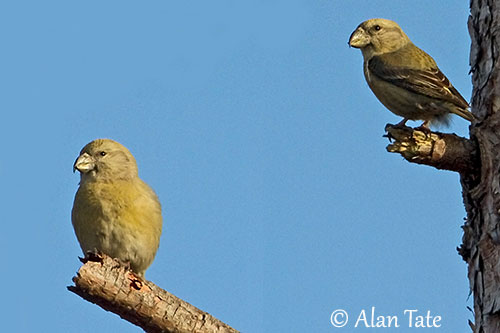
Parrot Crossbill
Loxia pytyopsittacus
Passeriformes Order – Fringillidae Family
INTRODUCTION:
The Parrot Crossbill is found in NW Europe and into W Russia, and there is a small population in Scotland. It is mainly resident, but it may move to South and West, depending on food resources.
It frequents conifer forests, especially pine forest or mixed conifer forests where it breeds and feeds on seeds of pine cones. It nests in a cup-shaped structure placed up to 20 metres above the ground in conifer tree.
The Parrot Crossbill is a little longer than the Red/Common Crossbill, and it is bulkier, with more massive bill. It is very close to the Scottish Crossbill in appearance, but it is slightly larger with thicker neck and more square bill shape. The best way to separate the three species is the voice, closely related to bill size.
The Parrot Crossbill is affected by degradation of the habitat caused by local removal of mature trees, but the population is currently stable and the species is not globally threatened.
